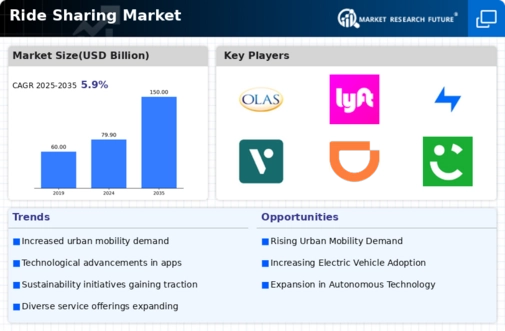Market Share
Introduction: Navigating the Future of Mobility: Competitive Dynamics in Ride Sharing
The ride-hailing market is experiencing an unprecedented degree of competition, the result of the rapid growth of technology, the changing regulatory environment and changing passenger expectations for convenience and sustainability. IT companies, manufacturers, IT service companies and new, disruptive AI companies are using advanced technology, such as big data, AI and automation, to improve passenger experience and optimize operations. For example, AI-based algorithms optimize ride-matching and dynamic pricing, and greening the operation is a way to appeal to environmentally conscious consumers. Moreover, as the ride-hailing market develops differently in different regions, strategic trends are emerging, especially in major cities, where demand for shared mobility solutions is growing rapidly. These trends can help companies adapt to the regulatory environment and increase market share.
Competitive Positioning
Full-Suite Integrators
These vendors offer comprehensive ride-sharing solutions, integrating various services to enhance user experience and operational efficiency.
| Vendor | Competitive Edge | Solution Focus | Regional Focus |
|---|---|---|---|
| Uber | Global leader with extensive network | Ride-hailing and delivery services | Global |
| Lyft | Strong brand loyalty in North America | Ride-hailing services | North America |
| DiDi | Dominant player in Chinese market | Ride-hailing and mobility services | China, Latin America |
| Grab | Diverse services beyond ride-sharing | Ride-hailing and super app services | Southeast Asia |
Regional Players
These vendors focus on specific geographic markets, providing tailored services to meet local demands.
| Vendor | Competitive Edge | Solution Focus | Regional Focus |
|---|---|---|---|
| Ola | Strong presence in India | Ride-hailing services | India, Australia |
| Bolt | Affordable pricing model | Ride-hailing services | Europe, Africa |
| Careem | Local expertise in Middle East | Ride-hailing and delivery services | Middle East, North Africa |
| Curb | Focus on taxi services integration | Taxi and ride-hailing services | United States |
Specialized Technology Vendors
These vendors provide innovative technologies and platforms that enhance ride-sharing operations and user experiences.
| Vendor | Competitive Edge | Solution Focus | Regional Focus |
|---|---|---|---|
| Via | Dynamic ride-sharing technology | Shared ride solutions | North America, Europe |
| Gett | Corporate transportation focus | Business ride-hailing services | United Kingdom, Israel |
| BlaBlaCar | Long-distance carpooling expertise | Carpooling and ride-sharing | Europe, Latin America |
Emerging Players & Regional Champions
- Bolt (Europe): Offers affordable ride-hailing services with a focus on electric vehicles, recently expanded operations in Eastern Europe, challenging established players like Uber by providing lower commission rates to drivers.
- Gojek (Southeast Asia): A multi-service platform that includes ride-hailing, food delivery, and digital payments, recently partnered with local governments to enhance urban mobility solutions, complementing traditional taxi services.
- Ola Electric (India): Focuses on electric ride-sharing solutions, recently launched a fleet of electric vehicles in major Indian cities, positioning itself as a sustainable alternative to conventional ride-sharing services.
- Lyft (USA): While established, it has recently pivoted towards integrating public transportation options into its app, challenging traditional ride-sharing models by promoting a multi-modal transport approach.
Regional Trends: In 2024, the market for ride-hailing is undergoing a marked shift towards greater responsibility, with a growing emphasis on electric and hybrid vehicles. In regions such as Europe and Southeast Asia, there is a greater reliance on multi-service platforms that combine ride-hailing with other mobility services. In addition, to improve urban mobility and to overcome regulatory challenges, companies are increasingly forming alliances with local governments.
Collaborations & M&A Movements
- In the summer of 2017, the two companies extended their partnership, aiming to integrate Waymo’s self-driving technology into the Uber ride-hailing platform, hoping to increase safety and reduce costs, thereby strengthening their competitiveness in the self-driving ride-hailing market.
- Lyft acquired a minority stake in electric scooter company Bird in early 2024 to diversify its mobility offerings and improve market share in the micro-mobility sector, responding to increasing consumer demand for eco-friendly transportation options.
- The first is the alliance with Toyota, a strategic partnership in the field of "intelligent driving"—a move that will enhance Didi's product offerings and put it in the lead of China's smart transportation industry.
Competitive Summary Table
| Capability | Leading Players | Remarks |
|---|---|---|
| Biometric Self-Boarding | Uber, Lyft | Uber has implemented biometric verification in select markets to enhance security and streamline the boarding process, while Lyft is exploring similar technologies to improve user experience and reduce wait times. |
| AI-Powered Ops Mgmt | Didi Chuxing, Grab | Didi Chuxing utilizes AI algorithms for dynamic pricing and route optimization, significantly improving operational efficiency. Grab has integrated AI for demand forecasting, enhancing service availability during peak hours. |
| Border Control | Uber, Bolt | Uber has partnered with local authorities in various regions to facilitate smoother border control processes for cross-border rides, while Bolt is focusing on compliance with local regulations to ensure seamless operations. |
| Sustainability | Lyft, Uber | Lyft has committed to 100% electric vehicles by 2030, leading the charge in sustainability initiatives. Uber is investing in carbon offset programs and promoting electric vehicle adoption among drivers. |
| Passenger Experience | Uber, Lyft | Uber's focus on personalized ride experiences through in-app features and customer feedback loops enhances passenger satisfaction. Lyft's emphasis on community engagement and driver partnerships fosters a positive user experience. |
Conclusion: Navigating the Competitive Ride Sharing Landscape
We have analyzed the market for shared rides in 2024. It is clear that competition is raging, with the market being shared among both old and new companies. The geographical differences in the market show that the demand for localized services is growing. This means that companies will have to tailor their services to the local needs. The old companies have the advantage of a long history and a wide network, while the new companies are concentrating on technology and customer-centric solutions. The strategic implications for companies are obvious: those who invest in AI for better customer experience, automation for better efficiency, and sustainable initiatives to appeal to the environment-conscious customer, and are flexible in their service offerings, will probably become the market leaders. These are the areas where the company's decision-makers have to put their energy in order to be able to navigate in the future and gain a competitive advantage.

















Leave a Comment